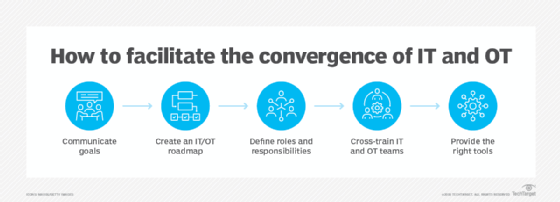5 ways to facilitate the convergence of IT and OT in IoT
Inherent differences between IT and OT teams can lead to conflict and a lack of cooperation. Learn how to align these two functions to ensure project success.
When an organization decides to implement a new IoT project, it's no longer purely a technology discussion. IoT bridges the domains of IT and operational technology to bring together everything from software and hardware to control systems and network solutions.
In many organizations, IT and OT groups have not worked together on deployments before and have different perspectives on IoT. IT is concerned with protecting enterprise data, while OT is focused on the production side of the business. More than ever before, successful business outcomes depend on the convergence of IT and OT. And the rapid spread of IoT devices throughout all types of businesses is bringing the two domains closer.
Businesses that combine traditional office settings and workflows with industrial systems and processes will find their technology infrastructure connected in ways they haven't been before. Industrial control systems, vehicle fleets and production workflows will no longer be disconnected from the very business they support. OT systems and devices will now connect to the enterprise network and the internet through IoT devices. IT networks, workflows and enterprise security will be affected by the influx of the more than 75 billion IoT devices that Statista estimated will be in place by 2025.
Gone are the days where anyone could just plug in a tech asset and get it working with no thought to the rest of the business. IoT now connects to and affects every area of a business, including the factory floor, logistics workflows and the head office.
IT professionals must learn how to integrate the additional data from and the security concerns posed by the new-to-them IoT devices from operational technology. OT professionals, on the other hand, must learn how their hardware and workflows integrate with the overall enterprise tech ecosystem and deal with new maintenance routines and security concerns.
Add in the cybersecurity risks with these new IoT devices, and it's clear that IT and OT can no longer work independently. The convergence of IT and OT must happen now to ensure the success and security of the overall business. The technological footprint of today's businesses is too complex for these areas to do it alone.
Three types of IT and OT convergence
The convergence of IT and OT tends to fall into one of three categories:
- Process convergence. The two teams work together as they have in the past.
- Data and software convergence. Front-office data and software work in concert with the tech stack of the organization.
- Physical convergence. IT and OT systems are physically integrated into a single system, such as edge computing systems.
Each type of convergence makes data and insights more readily available for use by everyone. Each group brings its expertise to the table, but only by working together will they be able to meet organizational needs and goals. IoT requires deep relationships, but IT and OT teams have traditionally been isolated from each other. Both groups have different priorities, reporting structures, workplace cultures and workflows that make it difficult for them to collaborate and communicate effectively on IoT projects.
How to close the gap between IT and OT
Bringing IT and OT teams closer together to ensure IoT project success is critical for today's organizations. Both groups wish to contribute to the organization's success, yet their inherent differences and traditional isolation often lead to conflict and a lack of cooperation. Organizations must learn how to align these two functions if they wish to preserve both the security and operational resilience of their technology and achieve the best business outcome.

Here are five ways organizations can facilitate the convergence of IT and OT teams.
Communicate the common goals for the project or initiative. Presenting a clear picture of the organization's overall objective enables both groups to recognize the long-term goals for IoT and work toward them together.
Create an IT/OT roadmap that outlines how and when IT and OT overlap. The plan should reflect both short- and long-term overlap. For example, define which team will manage the control systems, operate the security software, interact with third-party vendors and so on. The roadmap will facilitate dialogue between the two groups and keep conflict to a minimum.
Define specific IT and OT roles and responsibilities. Having the teams participate in this exercise together helps them understand the important capabilities and needs of the other team and underscores the value of both.
Arrange cross-training for IT and OT teams. As with any cross-training exercise, this step will give both groups a good perspective of what the other one does and what its needs are. It creates a solid foundation for understanding and collaboration because everyone sees things from the other perspective.
Provide teams with the right tools. Each team needs the right amount of visibility into the assets and communications of the IoT system so it can perform its specific duties to protect and maintain the system. For example, IT needs visibility behind the industrial firewall so it can perform threat analysis and cyber-risk management. Conversely, OT could potentially use the same tool to identify process inefficiencies and perform predictive maintenance on IoT hardware assets. Having the two teams select and approve a tool that provides them mutual benefits increases work satisfaction and team cohesion.
IoT devices are here to stay, whether you use them in an industrial setting or an office building. These devices need both IT and OT teams to work together to keep them functioning. But many organizations still have IT and OT strategies that work independently of each other, and that has to change. The convergence of IT and OT must be a high priority for organizations that wish to achieve success in their IoT initiatives.







